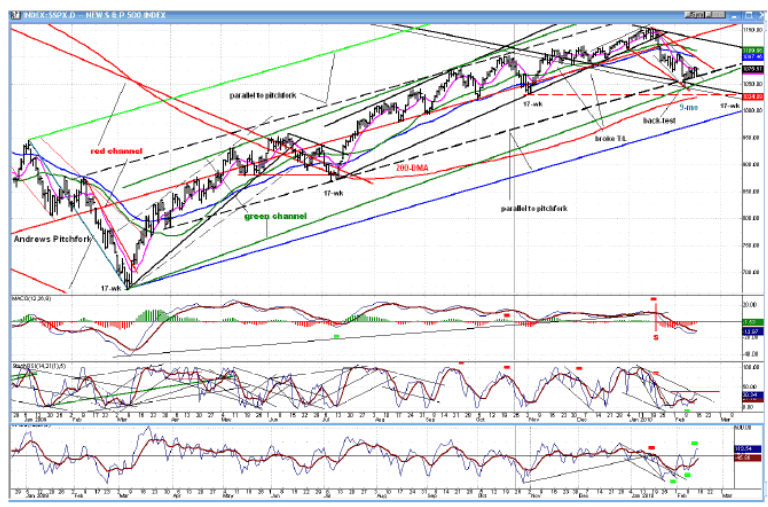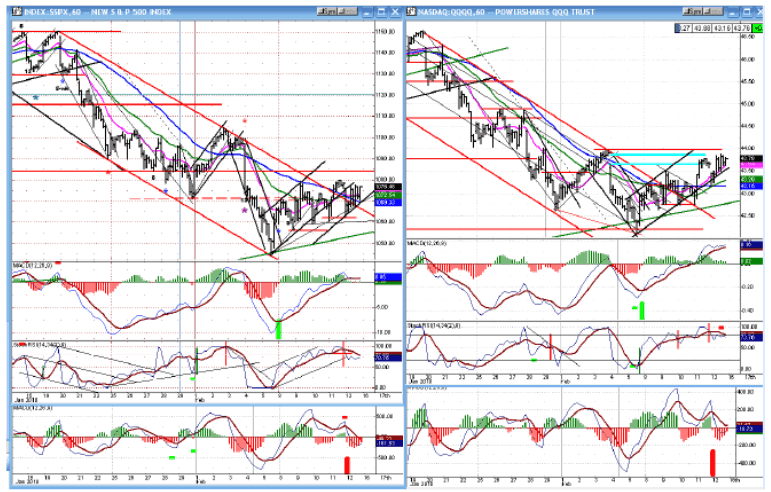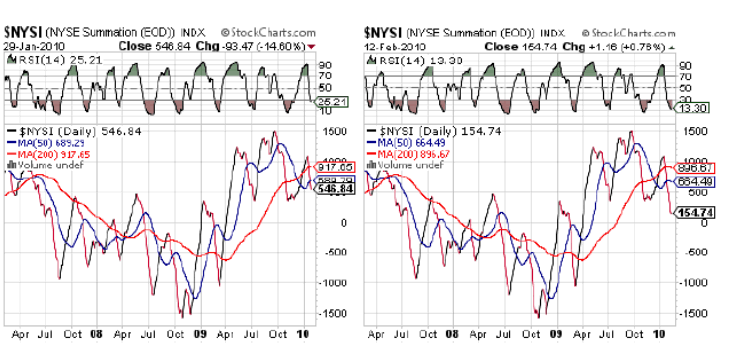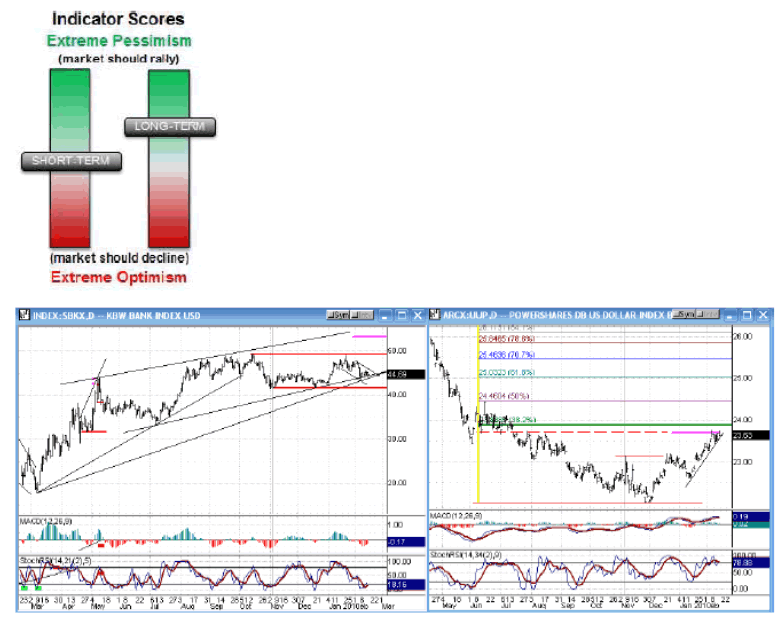Are We in a Stocks Bull Market and Bear Market?
Stock-Markets / Stock Markets 2010 Feb 16, 2010 - 02:18 AM GMTBy: Andre_Gratian
 Current Position of the Market
Current Position of the Market
Very Long-term trend - Down! The very-long-term cycles have taken over and if they make their lows when
expected, the bear market which started in October 2007 should continue until 2014.
SPX: Long-term trend - Up! We are in a medium-term bull market, which is a corrective move within a long term bear
market. This bull market should last until 2011-2012.
SPX: Intermediate trend - Technically, the index is still in an intermediate move until it breaks below 1029.
Analysis of the short-term trend is done on a daily basis with the help of hourly charts. It is an important adjunct to the analysis of daily and weekly charts which determines the course of longer market trends.
Daily market analysis of the short term trend is reserved for subscribers. If you would like to sign up for a FREE 4-week trial period of daily comments, please let me know at ajg@cybertrails.com .
Overview: Are we in a bull market and a bear market?

One of the first things that confronts a stock market analyst is semantics. How long is short-term? What is long-term? How do you define a bull market? I have that problem right now! So I am going to resolve it by saying that we are probably in a medium-term bull market within a long-term bear market.
I believe that the bear market which started in October 2007 ended in March 2009, and that we are now in a bull market which will last until 2011-12. HOWEVER, this entire bull market will be a corrective wave within a long-term bear market which also started in October 2007 but will not end until 2014, in conjunction with the 120-year cycle low (courtesy of Bud Kress of SineScope).
If we look at the Weekly Chart above, we can now clearly see that the bear market ended in March 2009 by coming out of a (red) bearish channel in June, after completing a 5-wave pattern. At the same time, it came through its 200-DMA. In July, it successfully back-tested its channel line and kept on moving up.
Since then, the SPX has moved in a narrow band in the center of an Andrews Pitchfork (dashed lines) pattern. It's inability to move to the top of the channel warns that it may break the lower trend line by the time the 4-yr cycle makes its low in the Fall.
In October, the index broke through the long-term trend line which goes back to the October 2007 top, but by then, it was in an overbought state and when it ran into the 200-wk EMA, it was a good occasion to take a breather and pull back to the trend line!
In the process of back-testing the long-term trend line, the index has found good support from the 34-wk MA, and the 50-wk EMA which happen to meet at this time. If that is not enough, the 200-DMA is just below the current low, ready to repeal the rest of the bears, if necessary.
The 4-year cycle which is bottoming in the Fall will probably take us to a lower level, but in the meantime, the 9-mo cycle which helped provide the correction probably bottomed last week and is now adding to the support. Looking back, it has a normal phase of 38 weeks which occasionally varies by 1-3 weeks.
With all this well-defined support, if the SPX trades below the 1029 level (the last short-term price low), we can deduce that we are in the process of resuming the bear market. Until then, we are still in an uptrend.
What's ahead?
Chart Pattern and Momentum
The Daily Chart (below) is very detailed. There are channels within channels, all relevant in analyzing the various trends which make up the main trend. A short-term sell signal was given when the SPX broke out of its bullish black channel from the July low, at the same time breaking the (red) median of the pitchfork.
The black channel represented the short-term trend which started in July '09. The trend has now expanded to the green trend channel which started in March '09 and represents the intermediate trend. The longer trend is represented by the Andrews Pitchfork pattern. You can see how the trading is currently confined to a narrow band between the dashed lines -- parallels to the pitchfork lines.
In October 2009, the SPX broke out of its long-term down-trend line, traded above it for 13-weeks and pulled back to back-test it. All the support shown on the weekly chart (above) should help make this back-test successful.
Additional support should come from the lower trend line of the intermediate green channel which started in March. We came to rest on its bottom trend line at the same time that we back-tested the long-term downtrend line. The 200-DMA is about 20 points below our recent low, just in case the bears have some fighting spirit left in them.
If my assumption that the 9-mo cycle has just bottomed is correct, the trend-pressure should now turn upward and we should already have made a reversal of the decline from 1150. The only near-term challenge left is the bottoming 17-wk cycle (formerly incorrectly labeled 90-day cycle) which is a mighty adversary and should be respected. It is scheduled to make its low about the first week in March. We need to see what kind of an effect it will have on the index before being certain that we have made a short-term low.
We will not have a confirmed resumption of the uptrend until price moves out of the red channel, which would also put it above the 50 DMA. If we do that, with the two cycles at our back, there is a very good chance that we can continue up for another 2 or 3 months. Let's say that we make a high in May, along with Terry Laundry's "T" projection. By then, the top green channel line will be above 1300 and could easily accommodate a projection to 1190-1200 if we make a new high.
This will sound like fantasy to the bears but, considering the market position, it is certainly within the confines of technical possibility.

All the indicators are in a good position for a reversal. The lower (A/D) indicator is already leading the way with plenty of positive divergence to the price. The middle indicator, after showing some positive divergence at the low, appears ready to break out of its down-channel. And the top one is on the verge of crossing lines, which would give a buy signal.
Let's now move to the Hourly Charts of the SPX and of the QQQQ, side by side. Both indices have broken out of their down channels from the mid-January high. The QQQQ is more advanced than the SPX, and closer to moving above its former short-term high. It also resisted the decline much better. This relative strength is bullish for the market. However, the indicators are showing some negative divergence which is especially pronounced in the lower one (A/D), and we could have another pull-back before a good rally gets under way.
Friday could easily have been a much more negative day than it was considering the way it started, and if the intra-day rally which occurred on Friday follows through on Tuesday, the market tone could turn more bullish. The positive influence of the 9-mo cycle may prevail over the bottoming 17-week cycle, and we could have a clear buy signal before re-testing the lows. Let's see how it plays out.

Cycles
The 9-mo cycle is mainly responsible for the recent decline. It should have made its low on 2/5, exactly 38 weeks from its last presumed low.
The 17-wk cycle -- previously incorrectly referred to as the 90-day cycle -- has been a very dominant cycle. It is estimated that it will make its low about the first week in March.
Longer-term, the 4-year cycle should exert pressure in the second half of the year.
Projections:
Previous projections:
By breaking below 1085, the SPX has given a projection to 1050-1058. We should also keep in mind that .382 retracement of the move from July to the top is 1043.
- If we break below 1029, the next projection is 970.
- A normal test of the highs would take us up to 1130-35.
- A resumption of the uptrend could reach 1190-1200.
Breadth
Note the difference between this week's NYSE Summation Index (courtesy of StockCharts.com) and last week's. The RSI is now at the level from which it normally reverses. It also shows some subtle positive divergence to the index. This is more evidence that a bullish scenario is developing. However, since the index made a new low along with the market, it may be a warning that the coming rally will be confined to a test of the highs.

After showing some positive divergence at the last low, my daily A/D indicator is on the verge of giving a buy signal, but has not yet done so. A strong advance on Tuesday would probably clinch it.

Something that has bullish implications occurred on Friday: the SPX opened lower, and in the first hour was down 15 points with net declining NYSE issues of -2108. That was the low point of the day. By the close, the index was still down -2.96, but the A/D closed a positive 172.
Such a rapid A/D recovery from a very negative number of issues in the first hour is unusual and I don't recall ever seeing it before. It smacks of accumulation and adds to the list of bullish signs appearing at this level.
Market Leaders and Sentiment
The long-term sentiment indicator (below, courtesy of SentimenTrader) continues to show readings that do not support a bearish view of the market, while the short-term one is neutral. It matches the position of my indicators which are a little overbought short-term but are developing a bullish longer term condition.

On the left, above, is a chart of the Banking index. It did not participate in the decline to the extent that the major equity indices did, and its indicators are in a position of giving a buy signal. If it holds above its recent low and breaks out of its short-term decline pattern, it is very likely to make a new high to about 53 (pink line).
On the right, is the UUP dollar index. It just completed a rally to its projection which almost retraced .382 of the last phase of its former decline into the lower confines of overhead supply.
Both indices are leading indicators for the stock market. The UUP, reversely so.
Summary
By declining to 1044.50, the SPX has retraced almost .382 of its up-phase from July 2009. This was most likely engineered by the bottoming 9-mo cycle at a time when the equity indices were very overbought and needed a correction.
The 9-mo low is now most likely behind us, but the 17-wk cycle is due around the first week in March and could prevent a full-scale reversal until it has made its low.
After the second cycle has bottomed, the index should experience a recovery which could lead to about 1135, minimum, in a test of the highs, or even to a new high before the 4-year cycle begins to exercise downward pressure into the Fall .
The following are examples of unsolicited subscriber comments:
Awesome calls on the market lately. Thank you. D M
Your daily updates have taken my trading to the next level. D
… your service has been invaluable! It's like having a good technical analyst helping me in my trading. SH
I appreciate your spot on work more than you know! M
But don't take their word for it! Find out for yourself with a FREE 4-week trial. Send an email to ajg@cybertrails.com .
By Andre Gratian
MarketTurningPoints.com
A market advisory service should be evaluated on the basis of its forecasting accuracy and cost. At $25.00 per month, this service is probably the best all-around value. Two areas of analysis that are unmatched anywhere else -- cycles (from 2.5-wk to 18-years and longer) and accurate, coordinated Point & Figure and Fibonacci projections -- are combined with other methodologies to bring you weekly reports and frequent daily updates.
“By the Law of Periodical Repetition, everything which has happened once must happen again, and again, and again -- and not capriciously, but at regular periods, and each thing in its own period, not another’s, and each obeying its own law … The same Nature which delights in periodical repetition in the sky is the Nature which orders the affairs of the earth. Let us not underrate the value of that hint.” -- Mark Twain
You may also want to visit the Market Turning Points website to familiarize yourself with my philosophy and strategy.www.marketurningpoints.com
Disclaimer - The above comments about the financial markets are based purely on what I consider to be sound technical analysis principles uncompromised by fundamental considerations. They represent my own opinion and are not meant to be construed as trading or investment advice, but are offered as an analytical point of view which might be of interest to those who follow stock market cycles and technical analysis.
Andre Gratian Archive |
© 2005-2022 http://www.MarketOracle.co.uk - The Market Oracle is a FREE Daily Financial Markets Analysis & Forecasting online publication.



